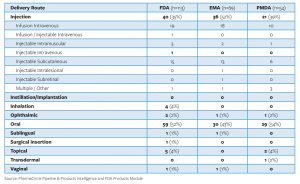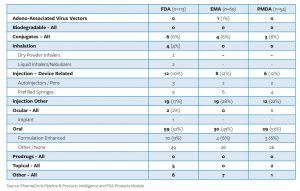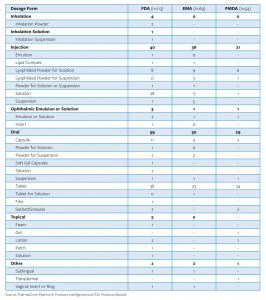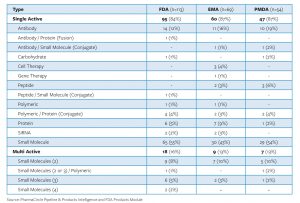Issue:March 2019
GLOBAL REPORT - 2018 Global Drug Delivery & Formulation Report: Part 1, a Global Review
One of a Four-Part Series
Part 1: A Global Review of 2018 Product Approvals
Part 2: Notable Product Drug Delivery and Formulation Approvals of 2018
Part 3: Notable Drug Delivery and Formulation Transactions and Technologies of 2018
Part 4: The Drug Delivery and Formulation Pipeline
By: Kurt Sedo, VP of Operations, and Tugrul Kararli, PhD, President & Founder, PharmaCircle
Introduction
The past decade has seen the unrelenting commoditization of drug delivery and formulation technologies.Technologies that a decade or two ago were considered breakthroughs and commanded premium pricing have become ‘off the shelf’ items. It has also resulted in part with a shift of the pharmaceutical industry’s focus away from small molecule therapeutics to biologics that address high value medical indications and provide extended market exclusivity. It has also coincided with a period where there have not been any ‘must have’ delivery technologies developed, for small molecules or biologics.
Until recently this new crop of macromolecule therapeutics has not required the benefi ts of drug delivery and formulation enhancement to distinguish themselves from competitors. This is likely to change as more companies face competitive ‘me-too’ biologics, biogenerics start to erode first generation product sales, and novel small molecule therapeutics are discovered that deliver comparable therapeutic benefits with simplified dosing protocols.
What’s needed is a renaissance in drug delivery and formulation technology development, the type that was seen four decades ago and lasted for the better part of thirty years. Drug delivery has had its greatest impact when it has identified whole new product ideas and delivered the necessary technologies. But this renaissance will require new ideas and the resources, financial and technical, to be realized. Are there really no big ideas beyond delivering macromolecules orally?
This four-part series looks at recent developments in the drug delivery and formulation sector with an emphasis on the past year. Data contained in these articles are drawn from the PharmaCircle Pipeline & Products Intelligence, FDA Product, EMA and PDMA modules that are sourced from public records with critical dissection of the data provided by PharmaCircle analysts. This first part looks at approvals in the three major world markets as a function of drug delivery and formulation parameters.
Biologicals and Small Molecule New Molecular Entity approval numbers in 2018 approached parity
Table 1: FDA Approval Numbers by Classification (2018)
Table notes: Multisource injectables are approved through the NDA rather than the ANDA regulatory process and can unintentionally skew the new drug approval figures.Type-5 approvals are not considered in the analyses presented on the following pages.
-Biologics, 351(a) and 351(k) approvals, achieved a new high in 2018 with a total of 34 therapeutic product approvals versus 17 in 2017
-A total of 9 Biosimilar, 351(k), approvals were granted by the FDA in 2018 versus 5 in 2017
-Of the 19 Novel Drug Approval Biologics approved by the Drugs Division, 11 were granted Priority review and 12 were classified as Orphan drugs
-Non-biological Novel Drug Approvals, single active and combination products, totaled 41 in 2018, an increase on the 34 approved in 2017
-New Dosage Forms totaled 28, including 23 sole active and 5 new combination products
-New Formulation or Manufacturer approvals totaled 40 but often related to relatively minor formulation changes and multisource injectable approvals
Injection Route approvals continue to gain share with the increasing development and approval of Biologics
Table 2: 2018 approvals by Administration Route
Table notes: The figures above do not include Type-5 Approvals (FDA), New Dosage Form supplements (FDA), Tentative Approvals (FDA) or Biosimilars (all).
-While the absolute number of Injection delivered products is similar for the FDA (19) and EMA (18), the difference in relative percentages is skewed by a much larger number of Oral aroute approvals in the US
-The distribution of approvals in Japan is more similar to the FDA than the EMA
-Notable by their absence are Nasal route products in all territories. The likely approval of nasal esketamine for severe depression in 2019 could offer new life to the Nasal sector
-There was only one new Transdermal route product approved in the three markets. This is consistent with a longer-term trend of limited novel transdermal product approvals
-After a few years of multiple annual approvals there was only one sublingual route new product approval by the FDA in 2018
Drug Delivery and enhanced formulation approvals are on the wane
Table 3: 2018 approvals by Drug Delivery Category
Table notes: The figures above do not include Type-5 Approvals (FDA), New Dosage Form supplements (FDA), Tentative Approvals (FDA) or Biosimilars (all).
-Most notable is the relative lack of drug delivery and formulation enhanced approvals, ranging from oral to injectable
-In terms of injectables, many of the products approved in 2018 are targeted to Orphan indications and used in a specialty care setting where enhanced self-administration is less important
-In the case of oral products there are fewer opportunities for simple formulation enhancements of previously approved actives. Oral actives are being selected on the basis of inherently more attractive pharmacodynamic properties and not in need of formulation improvement
-Not explicitly apparent in the table above is the absence of any approvals of abuse resistant modified release products using physical methods. One product using a prodrug approach, Apadaz, was approved but without abuse deterrent labeling. This may suggest the market is well serviced by existing products, a perceived lack of commercial potential for these products, or simply less regulatory appetite for these products
-Only one new Class II, III or IV opioid was approved by the FDA in 2018, a controversial dispenser version of sufentanil for sublingual administration
Approvals are increasingly associated with simpler dosage forms (Solutions and Tablets)
Table 4: 2017 Approvals by Dosage Form
Table notes: The figures above do not include Type-5 Approvals (FDA), New Dosage Form supplements (FDA), Tentative Approvals (FDA) or Biosimilars (all).
-Tablet, capsule and injection solutions accounted for 62% (147/236) of new product approvals in the three markets
-By market these three dosage forms accounted for 68% of all new drug approvals by the FDA, 62% by the EMA and 50% of PMDA approvals
-Of the tablet and capsule dosage form approvals only 21% (21/101) of new product approvals involved any type of drug delivery or formulation enhancement with the majority of these approved in the USA
There is remarkable consistency in approvals by Molecule Type across the major markets
Table 5: 2018 approvals by Molecule Type
Table notes: The figures above do not include Type-5 Approvals (FDA), New Dosage Form supplements (FDA), Tentative Approvals (FDA) or Biosimilars (all).
-Biologics accounted for one third (78/236) of non-generic new product approvals in 2018. In the USA this figure rises to 57% if only new molecular entities are considered
-Antibody related approvals accounted for 49% (38/78) of the biologics and macromolecule approvals in 2018. Not surprisingly, multi active (fixed dose combination) product approvals were limited to small molecules.
-Onpattro’s approval by the FDA and EMA represented the first approvals of a small interfering ribonucleic acid (siRNA)
-At this point biologics are largely used separately when combination therapy is deemed appropriate
Total Page Views: 5316















